A capo is a helpful assistant of every player, it is a small accessory that puts onto the neck of the guitar in order to shorten the length of its strings, raising the pitch. Fortunately, nowadays, find the best capo for yourself is not a problem. The modern market gives the possibility to choose from a great variety of different capos so anyone could find their perfect option.
If you want to be a versatile guitar player, there are not so many instruments that can be as helpful as capo is. Many fingerpicking songs require this accessory to be able to play them. Plus, the capo contributes to some great creative ideas. If you want to make playing guitar easier and more interesting, you definitely need to think about purchasing a capo.
Try to search for a guitar capo on Amazon and you will realize how confusing the choice of this device may be: it’s so hard to single out the most suitable one from such a big range of various models and types. And for a long-term playing, you will need only the top-quality tool that you can rely on. Our article is aimed to help make a decision. If you are still not sure which capo is right for you after reading our reviews, jump to the buyer’s guide and our recommendations will supply you with all the info you need to make a deliberate purchase.
Capo Reviews
Kyser Quick-Change Capo for 6-string Acoustic Guitars
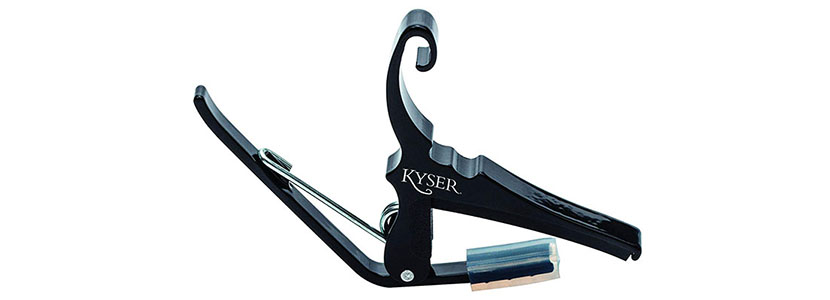
This handcrafted Kyser capo is tensioned to perfectly fit on 6-string acoustic guitars. However, in practice, it’s also suitable for electric guitars and can be used by both professionals and beginners. It’s supplied with a simple and reliable steel spring mechanism which makes it easier to adjust the capo. Its special design with curves and curls also contributes to easy adjustment. The device itself is made of an extremely light aluminum which ensures durability and makes the capo suitable for daily use.
This model is quite easy in usage but requires a good grip. It clearly raises the pitch of the guitar so you can play in a different key without troubles. This capo is designed for players who change the capo position frequently and allows transposing the guitar in seconds with just one hand. It makes the capo suitable for live performances.
Thanks to the replaceable silicone fitting, the device won’t mark or damage the guitar’s neck. The capo presses down on the strings very well so your guitar won’t have a fret buzz.
It’s quite old-fashioned capo and won’t be suitable for those who prefer accessories that look modern. At the same time, it’s quite simple so highly unlikely to break. Even if it may be tough at first, it will get more flexible with time.
Pros
- It’s available in 23 different colors to match with any guitar.
Cons
- The spring may seem too tight for someone.
- The paint may quickly fade in some areas.
- It may slip down if used on a guitar with a flat playing surface.
Donner DC-2 Guitar Capo for Acoustic and Electric Guitar
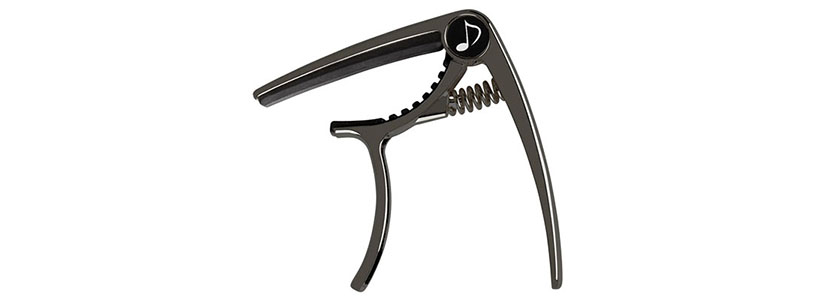
This model from Donner with concise and curved shape design can be the best capo for professionals as it’s of premium quality and made of a zinc alloy weighing like if it was made of light plastic. The steel spring mechanism with internal memory provides enough pressure, strength, and fatigue resistance. It’s also one of the most universal capos you can ever find on the market: it can be used not only for acoustic and electric guitars but also for ukulele, banjo, folk guitar, mandolin, and so on.
It’s safe to move the capo along the fingerboard thanks to the high-quality silicone pad. you won’t have to worry about scratches on the surface of your instrument. It is easy to change the position between frets with one hand. This capo will stay in tune no matter which fret you clip it on, and it’s easy to move around which is very convenient during a amming session or live performance.
This spring-loaded capo is very easy in usage and it will be suitable for those who are looking for minimalistic capos with simple functionality.
Pros
- It doesn’t cause fret buzzing.
Cons
- The clamping force may be too tight for instruments with large frets.
Shubb Deluxe Series GC-30 (S1) Acoustic Guitar Capo
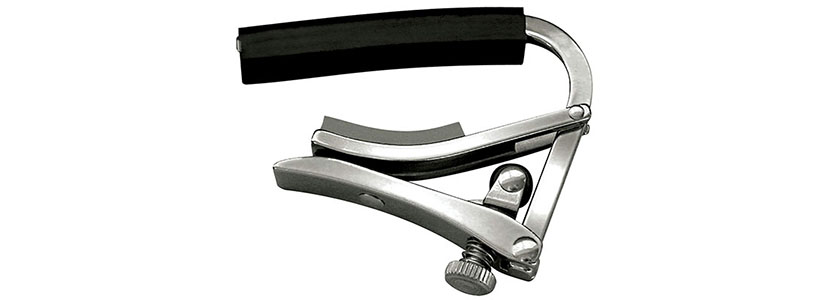
This Shubb capo is one of the most durable ones as it’s made of solid stainless steel which resists to the wearing and scratches. Despite the fact that it’s made of such a heavy material, it’s very compact and thin so it won’t add too much weight to your guitar. Besides, this capo looks so minimalistic so that it will match with almost any guitar. It’s supplied with a custom-made rubber which keeps the instrument in tune.
Its screw mechanism allows the capo to function smoothly and accurately: you can securely fix it in place with one flip of the lever lock. The capo provides the right amount of pressure and gives your hand more space without interfering with you during playing.
The Shubb Deluxe Series GC-30 (S1) puts an equal amount of pressure on each string so there is no need to worry that some strings can be lost while playing. And thanks to its specifically crafted design, you won’t face issues connected with unwanted spring vibrations.
However, note that it takes more time to adjust even in comparison with similar models so it’s not recommended for musicians who like to use a lot of capo positions during playing.
Pros
- You don’t need to reset the pressure with each use.
- It doesn’t compress to the fretboard.
- It’s quite versatile as it fits almost any guitar neck.
Cons
- The locking mechanism can become hard to release when you apply higher tension.
D’Addario NS Tri-Action Capo

The present capo is designed for the 6-string electric and acoustic guitars. It can potentially be the best guitar capo for those who dislike fragile capos as it’s manufactured from the solid aircraft-grade aluminum which can withstand rough use without even showing the signs of wear. Additionally, it’s quite lightweight material and adds minor weight to the neck of the guitar.
You can set the tension or pressure very finely with the help of a thumbscrew without damaging the strings. Besides, this capo is supplied with the micrometer which provides the right amount of pressure applied to the guitar’s neck. This way, you can make key changes without losing the intonation. The micrometer tension adjustment also ensures the buzz-free performance at any fret.
The tri-action geometry decreases the force required to open and close the capo. The direct horizontal pressure allows the D’Addario NS Tri-Action capo to effectively prevent the lateral string pull and the need for retuning during playing.
Pros
- The single-hand playing is possible.
- It features an integrated pick holder.
Cons
- The capo’s rubber pad doesn’t seem completely safe for the guitar surface as it’s prone to wear.
GUITAR CAPO (2-Pack) Made of Aircraft-grade Aluminum
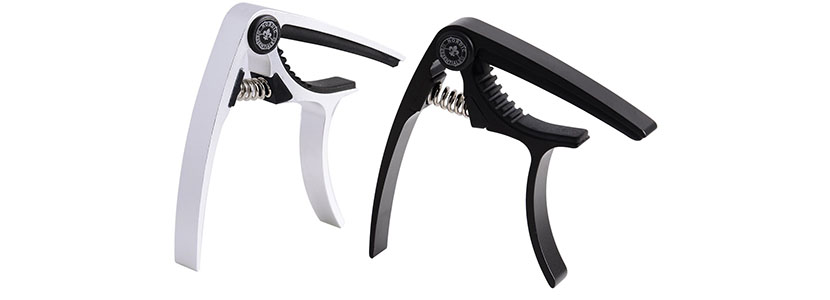
This pair of capos impresses with an extremely light weight: each one of them weighs only 1.2 oz. It’s safe to say that you won’t feel the capo’s weight on the guitar’s neck at all. Despite this, they are made of sturdy and lightweight aluminum metal.
This set of capos can be used for most 6-string and 12-string instruments, either for an electric or acoustic guitar, for ukulele, bass, banjo, mandolin, etc.
The protective pads are made of silicone and provide a tight grip that won’t damage the strings or neck of your instrument in the process of playing.
Thanks to its spring-action mechanism, the capo can be easily and quickly moved up and down the neck of your instrument. It stays firmly when you put it on the fretboard regardless of the position, so you won’t have to worry about buzzing.
If you are on a budget, this set from Nordic Essentials may be even more advantageous offer for you than some cheap capo as you will get two capos for the price of one.
Pros
- The kit includes two carrying pouches to store and transport the capos.
- They are compact and can be used with one hand.
Cons
- It may have more clamping force than you need.
- The capos have a tendency to pull the strings.
WINGO Guitar Capo for Acoustic and Electric Guitars
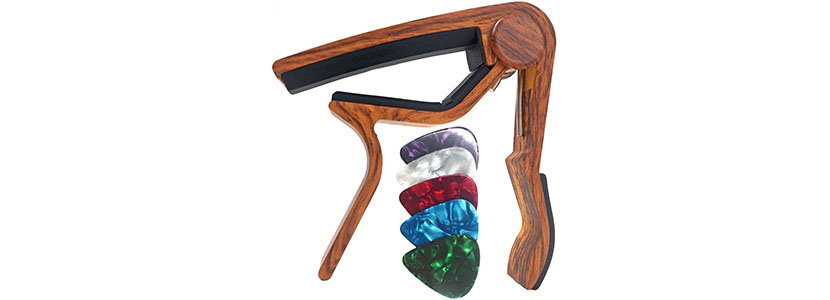
This capo from WINGO has a unique design as it looks like it was made of rosewood, but, in fact, it’s manufactured from a high-grade aluminum alloy to ensure a long time use. It’s quite universal and can be used not only as a capo for an electric guitar or capo for acoustic guitar as it’s also suitable for banjo, mandolin, and ukulele.
Its quick-release mechanism makes it easy to clip the capo on an instrument. The strong spring provides a well-balanced pressure which ensures a clear tone. The thick silicone pad protects the instrument from any kind of damage. It can be easily moved or removed so it’s suitable for players who like to change its positions frequently during playing.
Pros
- Firm enough to prevent most buzzing issues.
- It helps simulate higher tuning which makes it relevant for playing classical music.
Cons
- The clamping force may be too strong for nylon guitars.
Paige Original 6-String Acoustic Capo
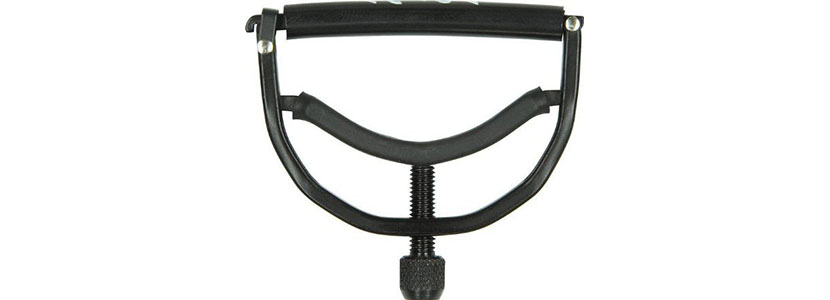
This U-shaped acoustic guitar capo from Paige has a sleek design and allows controlling tension. This way, you can perfectly adjust the capo to ensure the most convenient playing. It’s crafted from lightweight but sturdy metal and has rubber pads to provide a scratch-free moving. It easily moves around the fretboard and causes no issues with easy removing.
The capo offers even pressure distribution across all strings. It also has some definite benefit when it comes to ease of use thanks to the precise one-handed knurled-knob adjustment.
Its direct-tension construction eliminates string buzzing by pulling down on the strings from the capo’s center, rather than on the side as many other capos do. Such construction also guarantees that you won’t face any difficulties with the precision of adjustment.
Pros
- You can store the capo behind the nut when it not in use.
- The Paige Original is good for applying 90° perpendicular squeeze evenly to the fretboard.
- It can be used on guitars with wide necks.
Cons
- The clasp may seem very tight when you only start using the capo.
Buyer’s Guide
What is a Capo and Its Types
A capo is a tool used on the stringed instruments (guitar, ukulele, etc) to reduce the length of the strings. In simple words, it’s a clamp that presses the strings to the fretboard. It’s one of the most popular acoustic and electric guitar accessories (along with tuners, string winders, humidifiers, etc). This device is quite simple and very helpful for beginner musicians as it allows getting the most out of familiar chords and fingerings.
It’s important to know the types of capos as they differ by their clamping mechanism. Let’s take a closer look at the most popular ones:
A strap capo is the simplest and the cheapest type of capo. It attaches to the guitar neck with the help of a strap and is universal for all the guitars. The strap allows adjusting tension so you can be sure that it won’t leave marks on the guitar’s neck. At the same time, it will be hard to quickly fasten it during a concert or rehearsal. It also wears out quickly and not always guarantees a reliable string pressing.
A toggle capo, on the contrary, doesn’t require too much time for fastening. It’s very light, so you won’t even feel its weight on the neck of the guitar. The pressure can be adjusted with the help of the prongs. The rubber pad fixes the strings quite firmly and doesn’t leave scratches on the surface. However, a toggle capo is usually made of cheap material and breaks down quickly.
A spring capo is usually made of high-quality steel and is designed for guitars with metal strings. The spring mechanism allows installing the device quickly and easily. Thanks to the special rubber pads, the spring capo securely fixes the strings along the entire neck length. However, not all models allow changing the spring force which is not very convenient.
A screw-on capo operates by having a screw that must be tightened down to apply the pressure. Its main advantage is the opportunity to apply the tension as even as possible. It’s also among the most durable capos as it’s made of metal. However, the screw tightening may require a lot of time and effort in some models of capos.
How a Capo Works
Many inexperienced musicians refuse to use a capo because it causes too many questions: How does a capo work? What can it do? How it can be helpful and what are the benefits of using a capo? Let’s clear these points out.
The capo lets you use the same chords while increasing the pitch of your instrument without making you spend a lot of time tuning the guitar. When used properly, the capo imitates a chord finger press across the guitar strings. It helps ensure that you won’t sacrifice sound quality for the convenience of quick key changes. This device allows you to quickly change the key of the entire instrument at once or the key of just a few strings.
It can be very useful for beginner guitarists because it gives the opportunity to significantly expand the repertoire without the need to learn complex chords. This way, if you know the basic G, D, C, E, Am and how they can be transformed with the help of a capo, you can play more difficult compositions. In addition, it allows playing at the bottom of the fretboard, where less effort is required to play a chord. For example, you are playing a song written in the key of G minor. At the same time, this song has a lot of various chords and you have to constantly jump on the fretboard to play those chords. Just put the capo on the third fret and pick up the chord forms and you won’t have to put so much effort.
The capo also can make your instrument sound like another instrument. For example, if you put a capo on high frets (seventh or ninth) you can get an effect, comparable to the sound of a banjo.
Additionally, the capo allows playing chords without using a barre, expanding your possibilities in the usage of various chord forms.
The capo also contributes to improved singing. Moving it around the frets, you can find the most convenient key for your singing. In this case, you won’t even need to change the chords of the song.
Guide on How to Use a Capo
A capo can come in handy for both professionals and beginner musicians so it’s important to know how to use it. Follow the next steps:
Step 1. Choose the right capo
Except for finding the most suitable type of capo, you need to be sure that the device that you have chosen is safe for your guitar. When choosing a capo, make sure that there are no sharp or protruding edges that could damage the neck of your instrument. That part of the capo that will be pressed to the neck and the strings of the instrument should be covered with a soft and durable material (such as rubber, for example). A tough material can damage your guitar.
Step 2. Tune the guitar
It’s important to tune the guitar as good as you can before you set the capo on the fretboard. If not tuned, the guitar won’t sound perfect on each fret and some capos may exert excessive pressure on the strings making them sound sharper. The right guitar tuning will fix this problem.
Step 3. Set the capo
Place the capo after the nut of the fret (not in the middle between two nuts). The capo should be located as close to the nut as possible but shouldn’t touch it.
Step 4. Try to play in a new way to make sure that you use it properly
The capo should change the key of a guitar on open strings: if you play the C major key in an open position with a capo in the first fret, then it should sound like C sharp major and if the capo is in the second fret, then it should sound like D major.

Hi everyone! I’m Thomas Moody, also known as Guitarzan.
